Vietnam Travel Guide: The Best Places to Go and Travel Advice for the Vietnamese People
Practical travel tips and information for tourists visiting Vietnam
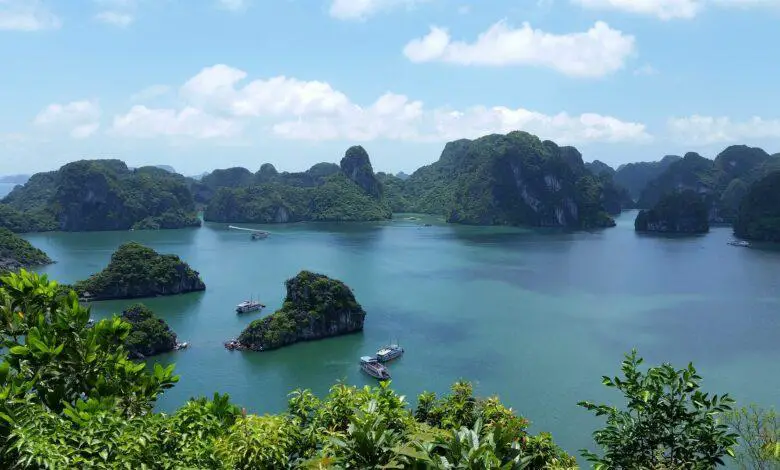
Practical information and advice for visitors to Vietnam
Where to Go in Vietnam?
Vietnam is a country known for its warm people and diverse culture. Nature lovers will be wowed by the country’s diverse landscape, which includes snow-capped mountains, winding river valleys, and verdant rice paddies, as well as its rich history and incredible cultural and ethnic diversity. Nature lovers and cyclists alike will enjoy exploring Vietnam’s many nature reserves, which are scattered across the country. Halong Bay offers breathtaking views of the sea, as well as exciting cruises that will introduce you to incredible new experiences.
Vietnam’s big cities, however, are known for their modern lifestyle and their abundance of authentic Vietnamese dining options, even if the countryside has some of the best views around. Vietnam is a fascinating country full of surprises and unforgettable experiences. It is one of Southeast Asia’s most beautiful travel destinations and one that should not be overlooked. We’ll go over some of the most popular tourist destinations in Vietnam in this article.
1- Halong Bay

Halong Bay has some of the most beautiful landscapes in the world and is a UNESCO World Heritage Site. This bay includes thousands of limestone islands, which have been eroded by wind and water over thousands of years to form jagged mountain peaks. Boats are the best way to enjoy these stunning views. You will need to take a long tour to discover this charming nature. There are many caves, including Hang Sung Sot Cave, known as Cave of Surprises, and Hang Dao Go Cave, which has many wonderful mineral and rock formations. And do not forget to enjoy a boat tour in this unique environment and see the various wonderful sights.
2- Ho Chi Minh City

A visit to Vietnam would not be complete without a visit to Ho Chi Minh City, which is a vibrant commercial hub. The streets of this city are always crowded with cars and motorbikes. The city includes many restaurants and cafes of international character, in addition to shopping centers that provide the best shopping experiences of its kind in the city. In the city center is Dong Khoi, a relatively small neighborhood that houses the city’s top tourist attractions and is easily navigated. There is the HCMC Museum, which houses an impressive collection of artifacts and artifacts that embody the city’s history. There is also the huge Notre Dame Cathedral, which was built in the late nineteenth century AD.
You can also visit Da Kao to see the ancient monuments of French architecture and the Jade Emperor Pagoda, which houses an impressive collection of Buddhist and Taoist religious icons. There is also the History Museum, which is an ideal destination for history lovers, as it houses a collection of artifacts from different archaeological sites.
On Nguyen Thi Minh Khai Street is the Reunification Palace, the residence of the President of South Vietnam, then known as the Independence Palace. At this location, North Vietnamese tanks stopped on April 30, 1975, to officially end the war. You will enjoy visiting this magnificent palace and seeing the sumptuous furniture from the sixties of the last century. Nearby is the War Remnants Museum, which has exhibits detailing the massacres committed by American forces during the Vietnam War.
3- Hue City

Hue is one of the most important historical cities in Vietnam, with many relics dating back to the time of the Nguyen emperors in the 19th century. The Imperial Enclosure is located on the banks of the scenic Perfume River, surrounded by massive walls that stretch for 2.5 km. And don’t forget to visit the South Gate, Ngo Mon Gate, Thai Hoa Palace with its exquisite interiors, Dien Tho Residence, the residence of the Queen Mother, as well as the Halls of Mandarins, famous for its magnificent ceiling frescoes. There are also many historical sites located nearby.
The Perfume River cruise is the best way to enjoy viewing this unique collection of archaeological sites. You can also discover many royal tombs and museums. And if you don’t have the time, you can visit the Tomb of Tu Doc and the Thien Mu Pagoda and its 21-meter-high tower.
4. Phong Nha-Ke Bang National Park

If you want to visit beautiful caves in Vietnam, Phong Nha-Ke Pang National Park is your ideal destination, a UNESCO World Heritage Site. In this beautiful natural area, you will enjoy watching many caves that contain different forms of mineral and rock formations. The Paradise Cave, which extends for a great distance of up to 31 kilometers below the surface of the earth, is the most famous attraction in the park. You can also visit Tu Lan Cave and enjoy swimming in the river water inside. You can take a boat and visit Phong Nha Cave. Phong Nha-Ke Bang National Park can be reached via Son Trach town.
5- My Son Temples

My Son is a group of temples dating back to the 4th century AD, surrounded by mountains and forests. This ancient Hindu religious center was widely used during the period from the seventh to the tenth centuries CE, and then ceased to be used completely in the thirteenth century CE. There are about 20 temples on this site, all of which are built of bricks or sandstone blocks, and show the influences of different Asian empires, including the Indian and Malaysian empires. Group B temples are the oldest, while Group A temples contain the most important monument, destroyed by American forces during the Vietnam War. My Sun Temples can be accessed via Hoi An City.
6- Hoi An

Hoi An is a fascinating city with historical architecture. In this beautiful city, you will enjoy discovering the old quarter full of old houses and trading forums dating back to the 15th century AD when the city was a major meeting point for Japanese and Chinese merchants who flocked there to trade in the local silk. Many of these archaeological sites are opened to the public to learn about the ancient history of this city. Perhaps one of the city’s most important landmarks is the Tan Ky House, which dates back to the 17th century and is famous for its unique architecture. Perhaps the most important landmark of the city is the Japanese Bridge at the western end of Tran Phu Street. There is also the Assembly Hall of the Fujian Chinese Congregation, which is the oldest temple in the city. In addition, there are many small temples and museums scattered throughout the city.
7- Rural areas of Sapa Countryside

The countryside of Sapa is famous for the green rice fields and mountain peaks of the Hoang Lien Mountains, which are still known by their old name from the French colonial period, the Tonknes Alps. In these rural areas, tourists enjoy an impressive array of unparalleled scenic views. The valleys in this region are home to many ethnic minorities, including the Hmong, Jiai and Red Dzau people, while rolling hills are surrounded by rice fields and overlook the country’s highest peak, Fansipan Mountain.
This area is the most important tourist destination in Vietnam, where many interesting activities are available, including hiking, visiting small villages and enjoying watching the wonderful mountains. The town of Saba itself is a promising tourist center that contrasts with the quiet nature of the surrounding countryside.
8- Hanoi city

Hanoi, the capital of Vietnam, is a vibrant city full of contrasts. In Hanoi, it is normal to watch motorbikes sprinting at high speed, and street vendors chanting loudly for their goods. Hanoi suffers from high levels of pollution. All in all, Hanoi is the ideal destination to discover the Vietnamese city lifestyle. The old quarter of the city has a special charm that attracts history lovers from all over the world. There are many great museums, including the Vietnam Museum of Ethnology and the Vietnam Fine Art Museum. There is also the Ho Chi Minh Mausoleum, which was built in memory of the founder of modern Vietnam.
9- Nha Trang city

Nha Trang is the perfect destination for beach lovers, with 6 km of beautiful sandy beaches. During the summer, these beaches are crowded with Vietnamese families and foreign tourists. Visitors can enjoy swimming in the clear blue water or relax on the soft sand under the golden sun. And if you want to have a little more fun, you can visit the Po Nagar Cham Towers, which are located to the north across the Xom Bong Bridge, and have been in use as a place of worship since the seventh century AD, and possibly before. There is also a wonderful museum dedicated to the work of Dr. Alexander Yersin, who discovered the cause of the plague and founded the Pasteur Institute in Nha Trang (which still runs vaccination programs in Vietnam today).
10- Cu Chi Tunnels

The Kuching Tunnels are a vast network of tunnels that stretched over 250 kilometers and were used during the war in the area around Ho Chi Minh City. A visit to these tunnels is a wonderful experience for all visitors to Vietnam, not just those interested in the military history of Vietnam. You can visit two short sections of the tunnel network accompanied by a guide who will take you inside these narrow tunnels, which is of course an unsuitable experience for those with claustrophobia, as you will literally crawl on your hands and knees in places. You can access the tunnels via the village of Ben Dinh or the village of Ben Duoc.
11- Ba Be National Park

Bape National Park is a must-see, with three interconnected lakes in the middle, surrounded by jagged mountain peaks and vegetated cliffs. Most visitors come to this destination to enjoy boat trips on the lake and discover caves with amazing mineral and rock formations. There are also many other activities, including hiking and discovering the hills between villages inhabited by ethnic minorities. This area is one of the most peaceful places in Vietnam, where tourists spend the night in traditional houses scattered along the lake, allowing them to enjoy a wonderful experience and discover the simple rural way of life.
12- Mekong Delta

The Mekong Delta lies in the far south of Vietnam, where the Mekong River finally finds its way to the sea through a maze of waterways that crisscross the floodplains. One of the must-see destinations is the Mekong Delta, a very fertile area dotted with rice fields and mangroves. The Mekong Delta is a vibrant region with floating markets that can be visited by boat. The famous Can Tho can be used as a starting point to discover this wonderful region due to its proximity to the floating markets of Phong Dien and Cai Rang. Boat trips from Ca Mau allow you to discover the U Minh Mangrove Forest and the Cau Mau Nature Reserve.
13- Mui Né City

Formerly a quiet coastal fishing town, Mui Ne has evolved into a beautiful beach resort and a great destination for windsurfing, windsurfing and kite surfing. This city is not as popular as other beach destinations in Vietnam, so it has pristine beaches, and is a peaceful getaway all year round. This area is famous for its red sand dunes where tourists can practice sandboarding or rent private vehicles and enjoy an experience full of adventure and excitement. There is also the Fairy Stream between nearby fishing villages and towering orange limestone formations, a calm, shallow stream of water that eventually cascades. Tourists wishing to discover an experience beyond coastal life can visit the ruins of the Po Shanu Cham Towers, which bear witness to the history of the Cham Empire that dominated this region for centuries.
What is the best time to visit Vietnam?
Vietnam experiences strong seasonal fluctuations, with heavy rains falling on cities and villages, often causing floods and mudslides. If you are planning to visit Vietnam, the best time is from December to February when the weather is dry, but there are some exceptions. Southern Vietnam, where Ho Chi Minh City is located, experiences a more tropical climate, with year-round high temperatures and high humidity. Visiting these areas in the colder months means lower levels of humidity and temperatures, which helps to enjoy the visit.
In northern Vietnam, many regions experience a real winter, with temperatures dropping in Hanoi in December and January. In the Saba Mountains, you will see some snow during this period.
And if you’re visiting Danang to enjoy a great time at the beach or to travel through Hoi An ancient town, it’s best to arrive from February to May, when the temperatures are mild. The rainy season, especially during the months of September and October, sees heavy rain, in addition to storms and strong winds on the coast, so it is best to stay away from Danang during this period.
Travel tips for tourists traveling to Vietnam for the first time
Below, we will review together a set of important tips that will help you enjoy your visit to Vietnam without any hassles. When you visit Vietnam, you will find friendly people and a vibrant cultural scene, as well as a variety of terrain and stunning nature. But Vietnam is different from its two neighbors, Thailand and Japan, in that Vietnam’s infrastructure is not at the same level as its two neighbors. You may face some difficulties in Vietnam, including the high level of pollution and extreme poverty that forces local people to try to get money in any way, in addition to the possibility of being defrauded. These tips will help you enjoy a safe tourism experience in one of the most amazing countries on earth!
1- Obtaining a visa to visit Vietnam
It is essential to prioritize and address the most important things first. It may be surprising to see some people visiting Vietnam without having an idea of the visa requirements. Of course, the process of obtaining a visa is a difficult and confusing process, but it cannot be ignored. There are many companies that help you to obtain an entry visa to Vietnam online, including the company Vietnam Visa Pro . Upon arrival in Vietnam, be sure to check all your papers, especially those related to visa on arrival and pre-approval, as well as personal photos and money. You can use US Dollars or Euros but the exchange rates are not good.
Steps to apply for a visa online
1- Fill out the required information on the form
2- Pay the required fees
3- Get the approval letter via email within one or two working days
4- Bring along a pre-approval letter, two passport photos, entry and exit visa form, in addition to cash
5- Deal nicely with Vietnamese staff on arrival
2- Never underestimate the size of Vietnam
You will only realize the vastness of Vietnam when you use Google Maps to get to know the different places. It suffices to know that the distance between Hanoi and Ho Chi Minh City is more than 1,700 km, and the train travels it in 35 hours! Commuting in Vietam usually takes longer than other Asian countries, and you should keep this in mind when planning your trip.
3- Plan your visit smartly
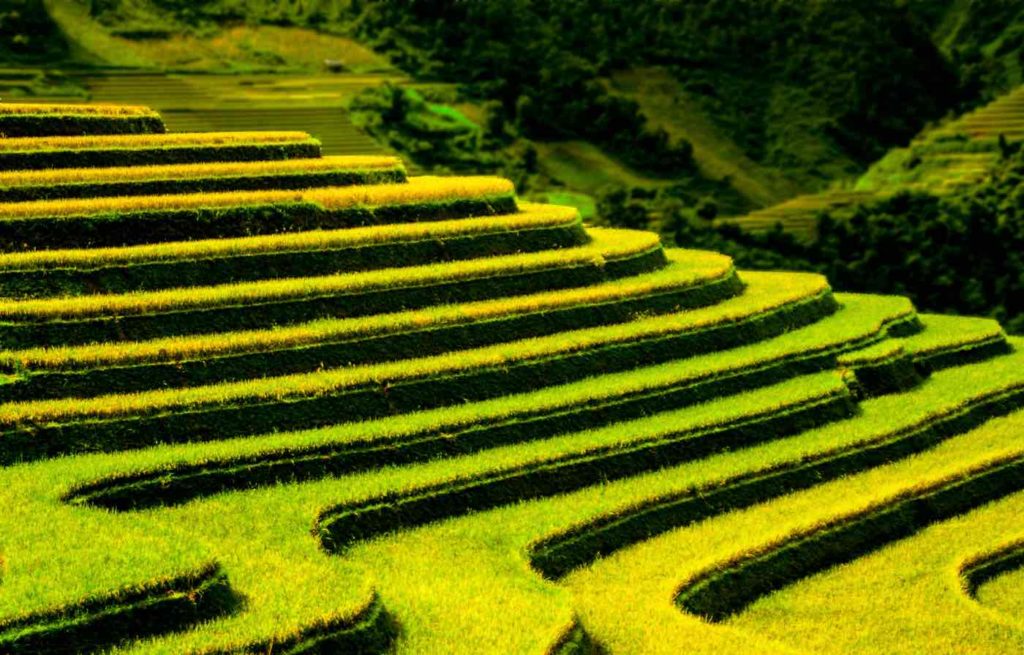
If you want to discover everything about Vietnam, you are making a big mistake. For example, if you are planning a comprehensive north-south tour, this tour should take at least 3 weeks, otherwise you will have to rush and resort to flights, thus not fully enjoying the experience. In general, Vietnam can be divided into 3 main regions, North, Central and South, and you will need an entire week to visit each of these divisions.
4- Vietnam has a diverse climate
In general, the weather in Vietnam is humid and hot. But due to its vast area, Vietnam is characterized by a variety of weather and surface appearances. For example, it may snow in Sapa while it is very hot on Phu Quoc Island.
- Northern Vietnam: The weather is hot and rainy and the winters are cold and dry. During the period from September to November, temperatures may drop, especially in the border area with China.
- Central Vietnam: The weather is hot and dry from January to August and temperatures can reach the mid-30s.
- Southern Vietnam: The climate is entirely tropical, and there is a rainy season and a dry season. It is best to visit Vietnam during the dry season from December to April.
5- Prepare to negotiate prices
Prices in Vietnam are very cheap, but there are no fixed prices, and there is room for bargaining. This can be exhausting at first, but you will get used to it over time. Mostly, the locals will try to inflate the prices, so you have to be careful about this. It is preferable that you do not appear rich so that you can get good prices, so avoid using expensive watches, luxury jewelry or large amounts of cash. And don’t forget to stick to the price you’re willing to pay, even if you pretend you’ll walk away without making the purchase.
6- Discover a great experience in Hanoi
You can discover the artistic and creative side of Vietnam more clearly in Hanoi, which still retains its ancient traditions despite the hustle and bustle of traffic. Hanoi offers tourists a wide variety of interesting activities, including visiting museums and temples, as well as discovering the simple, rural lifestyle in contrast to the lifestyle in Ho Chi Minh City. The Old Quarter, with its splendid winding streets, is an ideal destination for wandering, shopping and buying local produce and souvenirs. You can also enjoy tasting local delicacies, including the famous Pho. And each of these beautiful streets is devoted to the sale of one kind of commodity, for example, silver, chicken or other goods.
7- Vietnamese people are friendly and welcoming
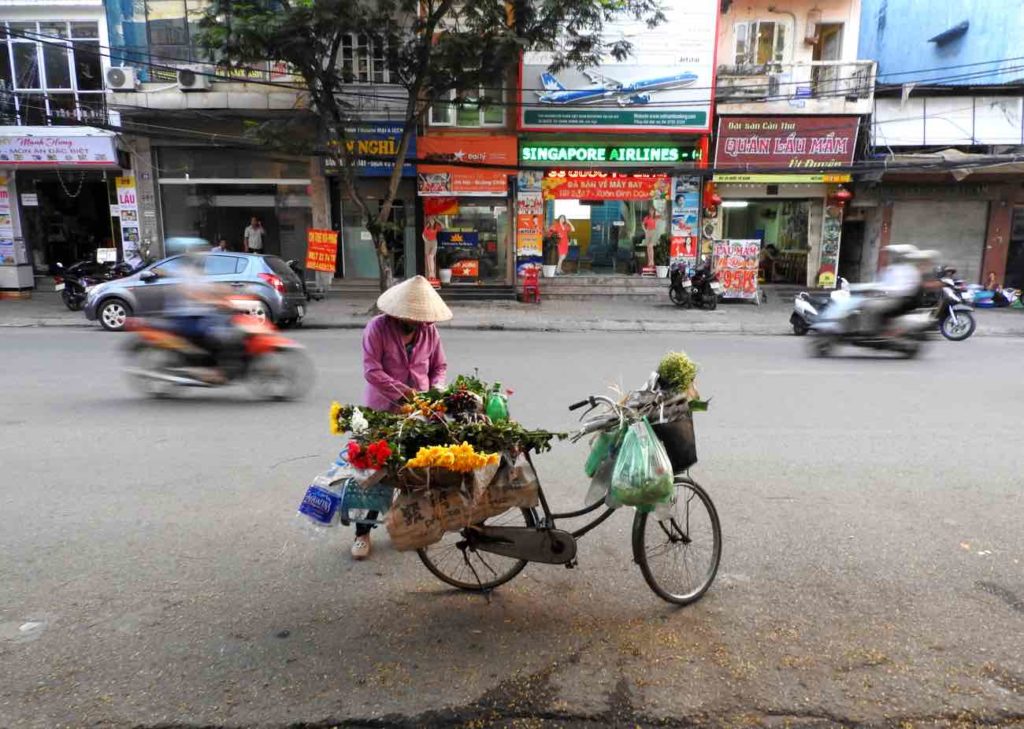
Most of the tourists would see the locals as being greedy and trying to take advantage of the tourists at all times. This impression may be true to some extent, because tourists see only the practical side of the locals trying to make a living. But when you connect with the locals on a human level, you will discover another side that is more welcoming and friendly. Inspiring stories and interesting experiences, perhaps some free food, and smiling and waving schoolchildren will greet you.
8- Beaches in Vietnam are not good in Vietnam

The beaches in Vietnam are not quite as good as the beaches in the Philippines or the islands of Thailand. When you visit the beaches of the Philippines, you will be disappointed when you see Sao Beach on the island of Phu Quoc with piles of rubbish piled up along 90% of its length. Perhaps the most important thing about Vietnam is the local cultural experiences, dining experiences, and learning about the inspiring stories of the local people.
9- Low value local currency

The exchange rate of the euro will be about 26,200 VND, while the US dollar exchange rate is about 22,700 VND. This means that 100 US dollars is equivalent to more than 2 million Vietnamese dong. The good news is that there are no coins in Vietnam. But be careful when dealing with fiat currencies, as you may be exposed to fraud.
10- Dress appropriately in Vietnam
Vietnam is not a conservative country when it comes to clothing. Due to the hot weather, tourists can wear light clothes without any reservation, so you can wear a light T-shirt and shorts without any embarrassment. But girls can’t wear bikinis, and men shouldn’t walk around without covering their upper body. When visiting temples and other religious sites, it is preferable to dress modestly as a sign of respect, and some restrictions may apply with regard to shorts and light clothing. And if you’re not sure about how to dress, try dressing up the locals. And don’t forget to bring heavy clothing when visiting the northern part of the country during winter.
11- Discover exceptional dining experiences like no other

Vietnam offers tourists exceptional dining experiences that blend sweet, spicy and sour taste. Vietnamese dishes contain a wide variety of ingredients, including tamarind, chili and plenty of fresh vegetables. There are many Vietnamese dishes to try, including Pho, which consists of noodles and meat soup topped with fresh herbs, Bun cha made with roast pork and noodles, and Goi cuon, which is spring rolls. Rolls stuffed with noodles, meat, shrimp or crab and vegetables, Cha ca, which is one of Hanoi’s favorites, which is white fish fried in butter with dill and green onions, and Nem Ran, which is served on special occasions, is Spring rolls stuffed with minced pork, crab or shrimp, mushrooms and dried onions.
12- Enjoy the tours in Vietnam
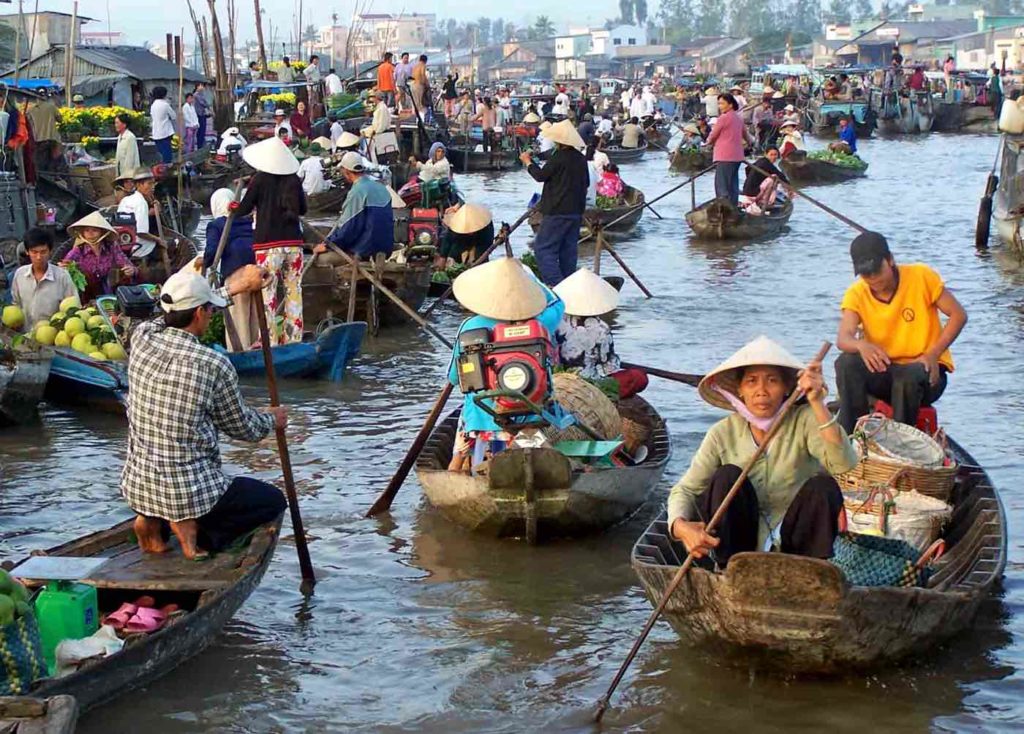
There are many tours that help tourists discover the most important tourist attractions in Vietnam, including the Maimung Delta, Kuching Tunnels, and Halong Bay. But sometimes these tours can be very bad experiences. There are countless reports of tourists being treated improperly and transported in droves in vans. It is best to avoid these tourist trips and rely on yourself in preparing an appropriate program to visit the most important tourist attractions in the country. And you can count on bicycles as a suitable means of transportation within cities.
13- Double check all arrangements before going on a tour
When you decide to go on a tour, be sure to check the credibility of the company organizing the tour, and do not forget that there are many companies with the same name. Do not book tours through your hotel because they will charge very high prices. Alternatively, you can search for travel agents or contact the companies directly. And be sure to ask all the questions that concern you, especially the number of tourists on this tour. In terms of price, tours are subject to price negotiation, just like anything else in Vietnam. It is common in Vietnam to pay a few dollars extra for better quality, especially if you are going on a two or three day tour and want more comfort and travel with fewer tourists.
14- Ho Chi Minh City is the best tourist destination in Vietnam

Ho Chi Minh City is a modern and vibrant city, which is the financial and commercial capital of Vietnam. If you are looking for a distinctive shopping experience or an exciting experience full of art, music and nightlife, Ho Chi Minh City is your ideal destination. This city is the first choice for tourists. The city offers its visitors a wide variety of amazing dining experiences, whether in street food carts or in fine restaurants. You can also enjoy the good taste of coffee in the cafes in Ho Chi Minh City. There are also rooftop bars that serve specialty drinks at reasonable prices and offer stunning views of the city.
15- The streets of Vietnam are always crowded

You may have seen some videos that describe the condition of some people who cannot cross the street due to the endless stream of motorbikes and cars. It is an accurate picture of the streets of Vietnam. Saigon has the largest number of motorcycles in the world. Also the traffic in Hanoi is not good at all. There are not many traffic lights or any interest in pedestrians. However, there is no need to panic, you will get used to it after a short time. In order to cross the streets in Vietnam, you must keep a slow pace in order to give the motorists and motorists a good chance to avoid you, and do not forget that Vietnamese drivers are very skilled at driving.
16- Great Wi-Fi
Internet in Vietnam is very fast, except when sharks cut underwater fibre-optic cables. Wi-Fi networks are strong and are found everywhere in Vietnam, and the speed of the Internet in some cafes in Ho Chi Minh City may reach 100 megabytes. And if you want to stay connected at all times, you’ll need a local SIM card. There are many options available at very reasonable prices. There’s Viettel, which offers a 20GB data connection for just $20 a month.
17- Keep your credit card
Never give your credit card to anyone else under any circumstances. For example, if you want to use your credit card in cafes or restaurants, do not leave your card to the waiter as you may be exposed to fraud or attempt to clone the credit card to steal the balance.
18- Prices are very cheap in Vietnam
Whenever you buy anything in Vietnam, be prepared to negotiate the prices. For example, you can eat a delicious meal in a restaurant for less than 5 dollars, and you can have a snack on the street for 20 cents. Some tourists can visit Vietnam with a budget of only $30 per day, including accommodation, transfers and meals. You can also take advantage of many great deals in malls and markets. The final price often depends on your ability to bargain and negotiate prices. Perhaps the most important shopping destination in Ho Chi Minh City is Thanh Market, which is a wonderful destination with hundreds of stalls selling clothes, textiles, appliances and handicrafts.
You can buy genuine and imitation leather belts for as little as $10. Vietnam has clothing factories for some international brands, and the products are sold for a third of their price in the USA and Europe. In Vietnam you will also find good Nike and Under Armor sportswear. You can also find good deals on electronics and phones, but there may be some risk involved. Mobile phone accessories are also available with prices starting at $1. The streets and shops are dotted with options for souvenirs at competitive prices.
19- Phu Quoc Island is overvalued
Tourists spend a wonderful time on the island of Phu Quoc, with its caves, bays, clear turquoise waters and unparalleled scenic views. But as a paradise of islands, tourists expect more fun on Phu Quoc Island. But the beaches on the island are not clean, with rubbish covering about 90% of Sao Beach, which is supposed to be the best beach in Vietnam. Despite this, the island is witnessing the construction of many new mega resorts and luxury hotels. Perhaps, over time, the island will not have any natural attractions to attract tourists.
20- Ninh Binh City deserves more attention
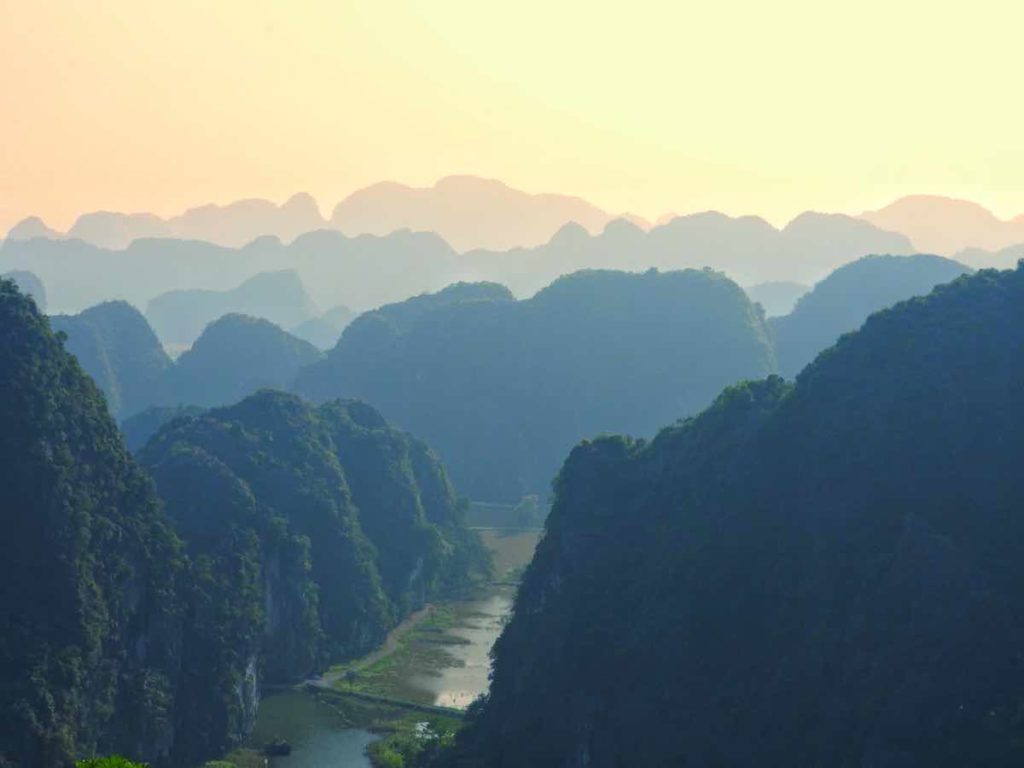
One of Vietnam’s most beautiful cities, Ninth Binh is dotted with massive limestone cliffs among rice paddies, ancient temples, and endless caves. This city offers plenty of beautiful views and scenery, and the locals are friendly and welcoming. In order to enjoy an authentic experience in this wonderful city, your tour should span at least two days.
21- Avoid using tap water
Vietnamese citizens know this well. Also, you should avoid using ice or eating salads because you don’t know how to wash the ingredients. And when you want to use a toothbrush, you can use bottled water. You can also use water bottles to wash your hands frequently. Thus, you can avoid 90% of cases of food poisoning and colic. Alternatively, you can use a water filtration system.
22- Learn how to use transportation smartly
In order to enjoy visiting different places in Vietnam, you must choose the appropriate means of transportation according to your destination and the distance you want to travel.
short distances
- Motorcycles: Motorcycles are the unofficial mode of transportation in Vietnam, with more than 45 million bicycles. The locals are keen to use motorbikes a lot in their daily life, to move and carry different things, including chickens and pigs! Motorcycle rental in Vietnam is inexpensive and starts at VND 100,000 per day. But if you do not have the necessary experience, avoid driving motorbikes in crowded cities.
- Bicycles: XE OM is a local mode of transportation using motorbikes.
- Taxis: Although the level of service has improved, taxis are often the domain of fraud and deception. Grab or Uber is preferred. But if you need to use a taxi, you can use one of the trusted companies, such as Vinasun.
- Grab or Uber: These are good options for getting around in Vietnam, as they are smooth and scam-free, and prices are good.
- Buses: Avoid using buses as they are very slow and uncomfortable.
long distances
- Buses: Buses are the most popular means of getting around in Vietnam for locals and tourists. There are many companies that provide buses with comfortable beds and Wi-Fi.
- Trains: The train system hasn’t been updated since the Vietnam War, so it’s uncomfortable and unclean. On the other hand, it is a way to enjoy watching the most amazing scenery, especially on the path between Hanoi and Sapa.
- Flights: Flights are not the best option to enjoy the experience of visiting Vietnam, but they save a lot of time and effort. Domestic flights are reasonably priced, especially if you choose a low-cost airline, such as Jetstar, Lion Air, Tiger or AirAsia.
23- Make sure to keep your belongings and personal belongings

Contrary to popular belief, Vietnam is a safe country that can be enjoyed at any time, as the country is almost crime-free, and the people are kind, gentle and calm. As is usual in all countries of the world, there may be some pickpockets in tourist places. And in some crowded cities, thieves on motorbikes may try to snatch tourists’ belongings while they’re out on the street. So be sure to follow the following precautions:
- Do not use any valuables in public while walking on the street.
- Put your valuables in your pockets, or use more than one bag.
- Avoid using your mobile phone while walking on crowded streets.
- Make sure your camera has a strap that fits well around your body.
24- Do not miss the opportunity to take a cruise in Halong Bay
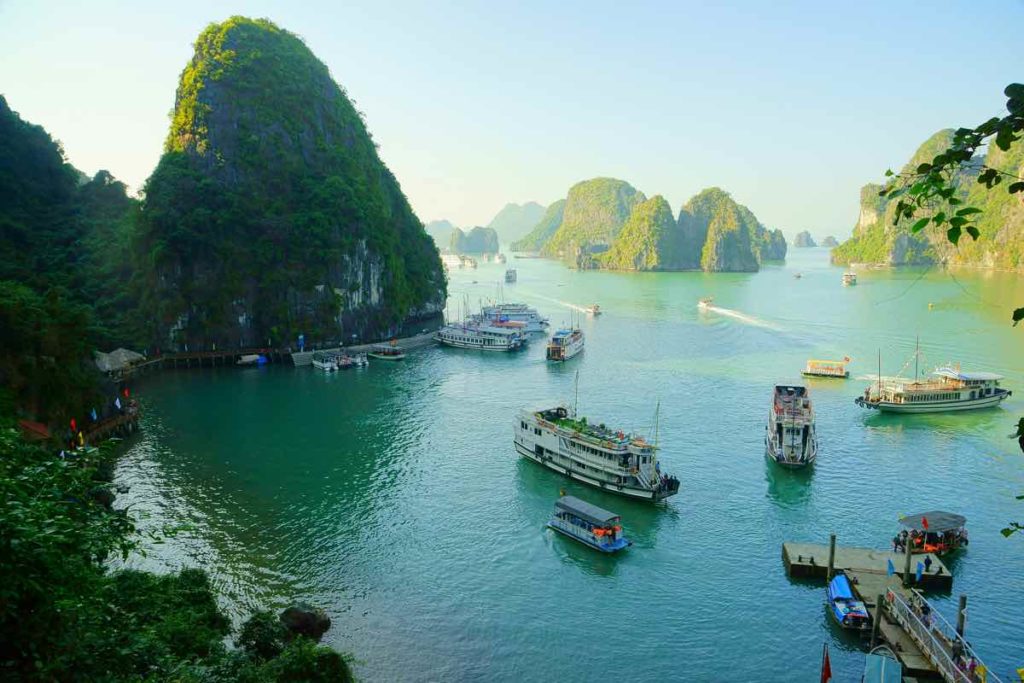
Halong Bay is the most important tourist destination in Vietnam, and this is evident when you see the number of boats full of tourists, which ply the bay throughout the year. Despite the crowds, Halong Bay is a unique tourist destination. In this beautiful area, you can admire the huge limestone cliffs, and boats are the best way to do the job. There are different types of tourist trips in Halong Bay, there are trips for one, two or three days. It is preferable to book a luxury flight because budget flights can turn into a nightmare. But it mainly depends on your budget. If you have enough money, you can book a luxury boat tour, and the trip includes a transfer from Hanoi and enjoying special meals, in addition to many other activities, including kayaking, tai chi and other activities.
25- Make sure to learn some Vietnamese words
The Vietnamese language has some complex sounds and words that can be difficult for you to pronounce. But anyway, it’s a good idea to learn some Vietnamese words and expressions so that you can easily communicate with and appreciate the locals. In Vietnam, very few people speak English fluently. Since Vietnam has been under European occupation for many years, we may find some words taken from the French language.
26- Discover unique dining experiences with street food
If you haven’t tried street food, you’ll miss out on a huge part of Vietnamese culture. Usually, street food is cooked in front of you, served on plastic plates, and enjoyed on small tables. Although there is no guarantee that these foods will be better than their counterparts served in restaurants or that they adhere to hygiene and hygiene rules, it is worth a try. Street food is a great way to discover an authentic Vietnamese experience, while at the same time saving money, as you can enjoy a delicious meal for just $1. Be sure to eat from the stalls frequented by locals, pay close attention to the cleanliness of cutlery and cook food well. If you are not sure, you can start with a small snack before ordering a full meal.
Popular Vietnamese Foods Tourists Should Try
Vietnamese food is known as healthy food and has a strong flavor, thanks to its unique blend of fresh herbs, vegetables, rice, noodles, seafood, pork and beef. Although there are many fine dining restaurants and five-star hotels in many cities, such as Hanoi and Ho Chi Minh City, the best Vietnamese dining experiences are found in unassuming restaurants, food stalls, and lively street markets.
A typical Vietnamese meal consists of rice or noodles, a meat or seafood dish, a vegetable dish, soup and fermented fish sauce nuoc cham. You can choose your favorite dishes according to your desire. Here is a list of the most famous and must-try foods when visiting Vietnam.
1- Pho dish

Pho is a specialty of Vietnam. It consists of rice noodles cooked in stew with different meat and vegetables, served with fermented fish sauce nuoc cham or chili sauce. The main course consists of sliced beef or beef balls with bean sprouts, lemon slices and fresh herbs, such as basil, mint, coriander and onions. You can also request to add some other components. This dish is eaten for breakfast and costs 20,000 to 30,000 VND at local restaurants and street markets.
2- Banh Mi sandwich

Banh Mi Ho is a sandwich that blends Vietnamese and French cooking, and is an ideal choice when you need a quick and tasty meal. The price of Banh Mi sandwich ranges between 10,000 and 15,000 VND. This delicious sandwich consists of toasted baguette, pickled vegetables, butter, soy sauce, cilantro, and chili. There are also a variety of filling options, including grilled pork, boiled eggs, fried fish with turmeric and dill, boiled sausages, Chinese-style roast pork and chicken.
3- Banh Xeo . (Crispy Pan Cake)

Pan zeo is similar to a crepe or pancake, and is prepared using rice flour, coconut milk and turmeric, and is filled with noodles, chicken, pork or beef slices, shrimp, onion slices, bean sprouts and mushrooms. Banh zio is served in most roadside stalls, local markets and restaurants, and its price ranges from 15,000 to 25,000 VND. It is often served with fresh lettuce, rice leaf rolls, and grilled pork skewers with lemongrass, mint leaves, basil and a fermented peanut sauce.
4- Goi Cuon . (Vietnamese fresh spring rolls)

Goi kun rolls consist of noodles, pork chops, shrimp, basil and lettuce and are wrapped in rice leaves. It is usually topped with ground chili, ground peanuts, and hoisin sauce. It’s a light and healthy snack that can be used as a perfect alternative to cha gio (fried egg rolls with noodles, minced pork and spices).
5- Mi Quang (Vietnamese turmeric noodles)

Mi Quang noodles are served in all restaurants in Vietnam, but its origins date back to the city of Dan Nang. This delicious dish consists of yellow rice noodles with bone broth seasoned with fish sauce, black pepper, shallots, garlic, shrimp, boiled quail eggs and roasted pork. As with most Vietnamese dishes, this popular dish contains a variety of herbs, including basil, peanuts, coriander, lettuce, banana flower slices, rice flakes and sesame.
6- Bun Thit Nuong (rice noodles with roast pork)

This hearty dish consists of thin rice noodles, chopped lettuce, cucumber slices, bean sprouts, pickled radishes, basil, chopped peanuts and mint with roasted pork. Unlike most noodle dishes, this dish is not served with meat broth, but rather with fermented fish sauce nuoc cham. You can also try the Bon Thin Nong Cha Gio dish with well-fried Vietnamese spring rolls.
7- Com Tam . (breaking rice) dish

Kom tam in Vietnamese means broken rice, and it is usually served with fried eggs and sliced green onions, as well as a selection of meats. This dish can be eaten at any time of the day at street markets and roadside food stalls, and is a relatively inexpensive dish that costs around 20,000 VND. There are many toppings that can be used, including roast pork chops, steamed pork and egg pancake. This dish is served with pickled vegetables, cucumber slices and fermented fish sauce nuoc cham.
8- Banh Cuon

Banh Con is a great option when you feel hungry while watching the tourist attractions in Vietnam. This delicacy consists of steamed ground rolls stuffed with minced meat (chicken, shrimp or pork), mushrooms, onions, Vietnamese cha lua sausage, steamed bean sprouts and cucumbers. For a more delicious flavour, fermented fish sauce nuoc cham can be used. Due to the great popularity of Banh Kun among tourists, there are stalls dedicated to selling it in the famous tourist places.
9- Sweet Xoi Xeo . Sticky Rice Dish
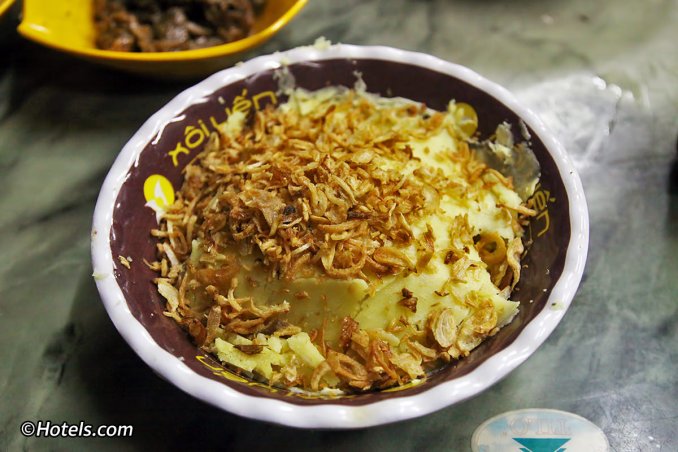
Sweet rice is a delicious Vietnamese snack topped with mung bean porridge, soy sauce and dried shallots. Ingredients vary from restaurant to restaurant, you can add boiled chicken, Vietnamese sausage, cha lua, marinated pork or preserved eggs. The main dish costs 15,000 VND, while each addition ranges from 15,000 to 30,000 VND. Coconut slices, toasted sesame, and sugar can also be added and served as a delicious dessert.
10- Ca Kho To

If you are a fish lover, you must try this delicious dish, which consists of fillets of catfish cooked in a clay pot. This dish is often served in southern Vietnamese cities, especially Ho Chi Minh City. This delicacy is prepared by slicing the catfish and cooking it in a thick broth prepared from a mixture of soy sauce, fish sauce, sugar, shallots, garlic and various spices. This dish is famous for its unique flavor that combines sweet and savory taste, and is served with white rice and fresh vegetables.
Tips on tourist accommodation and hotels in Vietnam
Vietnam generally has good accommodation options. In the main tourist areas, there are accommodation options to suit all budgets, and although the prices are a little high by Southeast Asian standards, the quality in general is also high. There is a big boom in the establishment of hotels and tourist facilities, and with the increase in the number of hotel rooms, the intensity of competition is intensifying, and thus prices in general decrease, and distinguished levels of service are provided. It is notable that there is a massive increase in the number of luxury resorts scattered along the coast that mainly target the Asian cruise market, while budget travelers will find good budget accommodations across the country.
With the increasing number of new hotels that have appeared in recent years, accommodation reservations are no longer a big problem, and luxury hotels offer great deals, especially on weekends. However, advance reservations are required at some times, including the Tet Festival or the Vietnamese New Year in early spring.
It’s easy to book your hotel accommodation online, and the tourism staff at Hanoi and Ho Chi Minh Airports can book a hotel room for you. But be careful not to ask taxi drivers or motorcyclists for advice so you don’t get scammed. To avoid such fraud, make sure to write the hotel name and street name on a piece of paper and give it to the driver. Once you find a hotel, check out different room types before making a final choice, as the standard of rooms may vary within the same hotel. Also, you should make sure that the beds inside the rooms fit your requirements.
Things you should know before booking a hotel or residence in Vietnam
When checking into the hotel, you will be asked to present your passport in order to register your details with the local authorities. The passport may be returned the same night, or held as security until check-out. If you do not want to leave your passport at the hotel, you can express your desire to keep it to finish some banking procedures, some hotels accept copies of your photo and entry visa. It is also usual to pay the bill for your stay when you leave the hotel, but some hotels require payment in advance. Hotel room rates vary according to demand, so be prepared to negotiate rates, and be sure to check if the rates offered are per room or per person. And you can get good rates if you are going to spend several nights in the hotel.
All hotels charge a 10% government tax, while luxury hotels add a 5% service fee. The room rate may or may not include these taxes, so you should check this out. The room rate usually includes breakfast, and in budget hotels, breakfast usually consists of bread with jam or cheese and a cup of tea or coffee. While some luxury hotels serve a large breakfast buffet. Prices are often quoted in Vietnamese dong, but due to the high volatility of the exchange rate (which can rise or fall by hundreds or thousands of dong each week), prices are subject to constant change.
Although conditions in Vietnam have improved, hotels may encounter some security issues. So, do not leave your valuables in your room, and keep documents, traveler’s checks, etc. in your wallet at all times. Usually, high-end hotels and many mid-range hotels provide safety deposit boxes, and you can sometimes leave your belongings at the front desk, but make sure to put them in a sealed envelope and ask for a receipt. In budget hotels that put locks on the doors, you can use another lock for added security.
In some of the old budget hotels, the rooms are cleaned infrequently and poorly, and cleanliness may be a problem for the guests, as cockroaches and mice roam freely inside the rooms. You can reduce health risks by not bringing food or sugary drinks into your room.
Laundry service is provided by all hotels and inns, and Western-style laundry and dry cleaning services are widely available in Hanoi, Ho Chi Minh City and other major cities. Clothes are often hand rubbed hard, so don’t send any clothes you’re afraid to discolor.
Finally, prostitution is widespread in Vietnam. In small hotels, tourists are harassed by girls and sometimes receive phone calls from them at night.
Accommodation options in Vietnam
There are various accommodation options in Vietnam, there are hostels, inns, and large hotels, but the description used to determine the level of accommodation you will receive cannot be relied on. Old hotels in Vietnam are state-owned hotels designed in the style of Eastern European hotels, while small private hotels are trying to be more innovative. Most hotels have different types of rooms, which include simple fan-ventilated rooms with cold water, and luxurious air-conditioned rooms with refrigerator, minibar and TV with various satellite channels.
In general, the more new the facility is, the higher its value in terms of service level, cleanliness and comfort. The country is witnessing the establishment of a large number of tourist resorts, which are not integrated tourist facilities, but simple hotels with beautiful landscaped gardens, located on the beach or in the countryside. Prices often include breakfast. You can have all your meals at the hotel.
Economy Accommodation Options
The cheapest type of accommodation in Vietnam is to have a bed in a dormitory, where you pay for the use of the bed and shared facilities. These establishments have private rooms, but the prices are higher than the common wards. In the main cities, there are some budget hostels, especially in the De Tham district of Ho Chi Minh City and in the Old Quarter of Hanoi. In Hanoi there is also a small network of Hostelling International accredited youth hostels, but you will need to purchase a Youth Hostel Card upon check-in.
If you are looking for more privacy, there are simple rooms with fan and shower, but you may not be able to get hot water in this room category. If you want an air-conditioned room with a TV that shows different satellite channels, and maybe even a window, the price may double. You can upgrade the room category for a larger room with better amenities, usually a refrigerator, bathtub, and possibly a balcony. Although most hotels advertise their TVs showing different satellite channels, the channels offered vary from place to place, not to mention the poor signal and quality of the channels.
Medium and luxury accommodation options
You can find comfortable accommodation options in Vietnam with prices starting at $30 per night. In this category of hotels, the rooms are spacious and comfortable, well-furnished, air-conditioning, hot water, refrigerator, telephone and a TV set with various satellite channels. And if you can afford to pay between $30 and $75 a night, you’ll get a good room in a mid-range hotel with a restaurant, bar, reservation desk, room service, and other services.
On the other hand, most of the world-class luxury hotels are located in Hanoi and Ho Chi Minh City, such as the Metropole Hotel in Hanoi and the Continental Hotel in Ho Chi Minh City. In recent years, many hotels and resorts have been established in Nha Trang, Hoi An, Da Nang and Ha Long. Every major city has one or two luxury hotels, while there are very few luxury hotels in the countryside.
Camping and accommodation in villages
With tourism booming in ethnic minority areas in Vietnam, cottages have become one of the most popular accommodation options in Vietnamese villages. In the north of the country, particularly near Sapa and the Mai Chau Valley, you can take a guided tour that includes accommodation in a minority village, or other arrangements upon arrival at your destination. In the Central Highlands, you can arrange accommodation in a cottage with the help of the tourism offices in Pleiku and Kon Tum.
This type of accommodation usually involves sleeping on a mattress on the floor in a common room, with a blanket and mosquito net provided. But for added safety, it’s best to take your own tools with you, and don’t forget that it’s cold at night in the highlands. Prices in villages vary according to the region and according to the meals served. There are guided tours organized in the Mekong Delta with accommodation with the owners of orchids to discover an amazing experience in the countryside. In Nha Trang and Mui Ne, hotels offer tents for a few dollars a night when all rooms are booked. Some tour companies also offer camping as an option when visiting Halong Bay.
Best Halal Restaurants in Hanoi
Are you finding it difficult to find halal restaurants in Hanoi? Don’t worry, in this article, we will review a list of the best halal restaurants in Hanoi.
1- Little India Restaurant

Little India Restaurant is one of the best halal restaurants in Hanoi, famous for serving a wide variety of Indian delicacies, including tandoori salmon, a delicious dish cooked in a tandoor oven. Each dish is presented in a unique way that reflects the origins of the dish, with the Hyderabadi-style lamb curry served in a small silver bowl, while the lentil soup is served in a bucket-like bowl. Make sure to visit this famous Indian restaurant for an unforgettable experience.
- Address: 32 Hang Tre Street, Hoan Kiem District, Hanoi
- Working hours: from 11:00 am to 2:30 pm, and from 6:00 pm to 10:30 pm
2- D’LIONS RESTAURANT
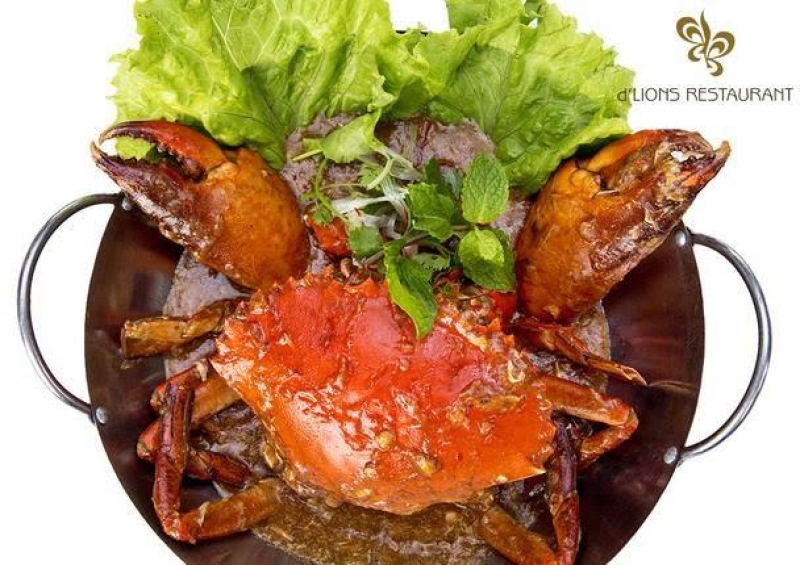
Discover an extraordinary experience away from the hustle and bustle of the city at the upscale Dellions Restaurant, famous for serving a wide variety of must-try Malaysian and Singaporean delicacies, including seafood dishes and fishhead and crab noodles curry.
- Address: 92 Le Duan Street, Cua Nam Ward, Hoan Kiem District, Hanoi
- Working hours: from 6:00 am to 11:00 pm
3- Red House Restaurant

Red House Restaurant is known for serving a set menu with a wide variety of Singaporean delicacies, including black pepper crab and chili and frog porridge. There is also a great selection of starters, desserts, noodles and soups. And don’t forget to try the tofu dish cooked with Red House sauce in a clay pot with chicken pieces and baby shrimp.
- Address: 01 Ngo Hang Bong Str, Hoan Kiem Dist, Hanoi
- Working hours: from 11:00 am to 11:00 pm
4- Khazana Indian Restaurant

This restaurant is famous for serving the most delicious Indian dishes in Hanoi. The menu features dishes from North and South India, including Goan Fish Curry and Chicken Vindaloo, as well as lamb Bhuna Mutton.
- Address: 34 Durong Thanh, Cura Dong, Hoan Kiem District, Hanoi
- Working hours: from 10:30 am to 2:30 pm, and from 5:30 pm to 10:30 pm
5- Tandoor Modern Indian Cuisine

Discover a modern Indian dining experience with a great selection of Indian dishes prepared by the most talented Indian chefs. The restaurant is known for serving vegetarian and non-vegetarian dishes from North and South India, including the famous chicken tandoori, which consists of slow-roasted chicken topped with various spices.
- Address: 24 Hang Be, Hoan Kiem, Hanoi
- Working hours: from 10:30 am to 10:30 pm
6- 1001 Nights Restaurant

Alf Leila Wa Leila Restaurant is known for its delicious halal dishes in a Mediterranean-inspired setting. Discover an authentic Arabic dining experience with your loved one, and savor the delicious taste of kebabs, grilled halloumi and cheese rolls, to name a few.
- Address: 37 Xuan Dieu, Quang An, Tay Ho, Hanoi
- Working hours: from 10:00 am to 12:00 am
7- Namaste Hanoi Restaurant

Located in the heart of Hanoi, Namasati Restaurant offers an exceptional menu featuring many halal delicacies inspired by the Hyderabad and Gurat regions, including lentil dishes, curries, butter chicken and lamb.
- Location: 46 Tho Nhuom, Tran Hung Dao, Hanoi
- Working hours: from 11:00 am to 2:30 pm, and from 6:00 pm to 10:30 pm
Read also: Everything you need to know about tourism in Cambodia
Sources:
- http://www.vietnam-guide.com
- https://www.geekyexplorer.com
- https://www.planetware.com
- https://www.roughguides.com
- https://www.halalzilla.com
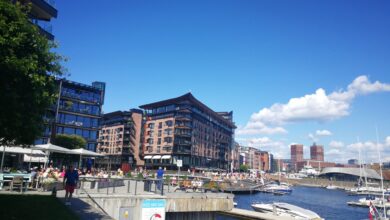
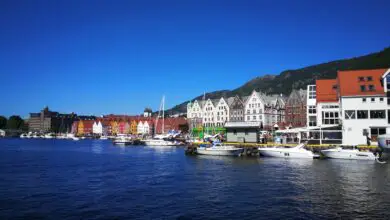
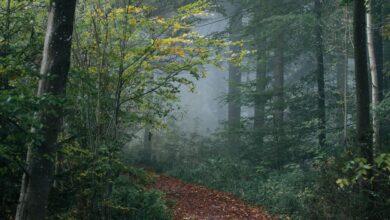
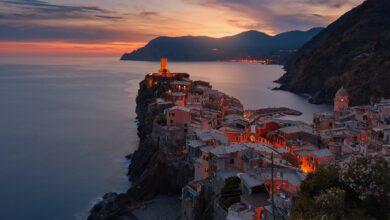
Facebook Comments